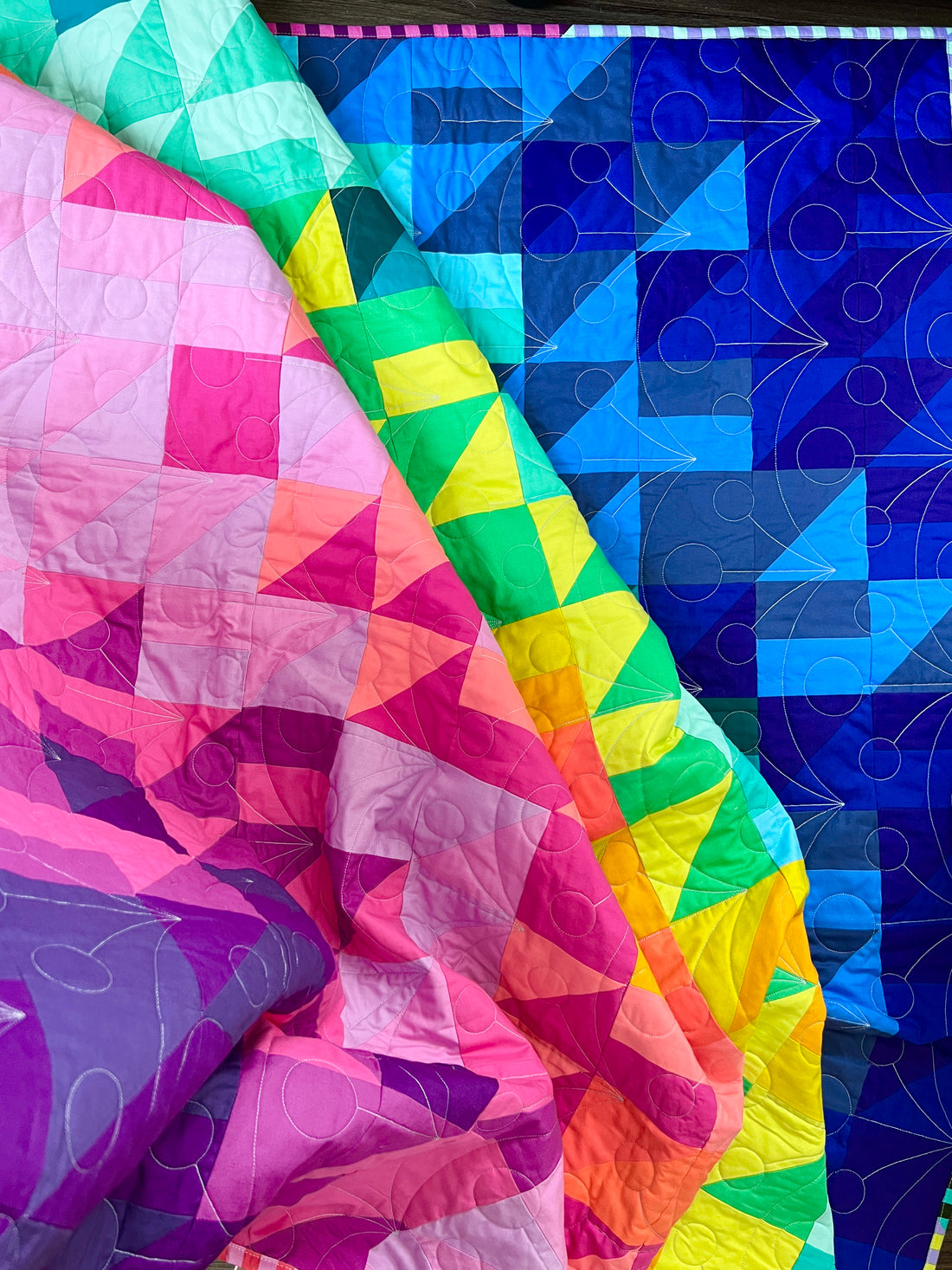
How to Care for Your Quilt: A Comprehensive Guide
Emily HerbsterShare
How to Care for Your Quilt: A Comprehensive Guide
Your quilt is more than just a blanket—it's a labor of love, a piece of art, and an heirloom to be cherished for generations. Proper care will ensure it stays vibrant and functional for years to come. Here’s everything you need to know about storing, washing, and treating your quilt.
Storing Your Quilt:
When not in use, proper storage is essential to maintain your quilt’s condition.
- Keep it clean before storing: Wash your quilt (if needed) and ensure it’s completely dry to prevent mold or mildew.
- Store in a breathable container: Avoid plastic bags or bins, as these can trap moisture and lead to discoloration. Opt for a cotton pillowcase or a muslin storage bag instead.
- Avoid direct sunlight: Prolonged exposure to sunlight can fade your quilt’s fabrics. Store it in a cool, dry, and dark place.
-
Rotate your quilts: If you have several quilts in storage, take them out periodically, refold them along different lines to prevent permanent creases, and air them out.

Washing Your Quilt:
Quilts don’t need frequent washing, but when it’s time, handle them with care.
Pre-Wash Checklist:
- Check for loose threads or weak seams and repair them before washing.
- Test fabric colorfastness by dabbing a damp cloth on the fabric.
- Use a bathtub or large basin filled with cold water.
- Add a small amount of gentle detergent (like Orvus Paste or a fragrance-free, dye-free detergent).
- Gently agitate the water, avoiding wringing or scrubbing.
- Drain the water and rinse the quilt thoroughly with cold water until the detergent is gone.
- Use a front-loading washing machine to prevent agitation damage.
- Wash on a gentle or delicate cycle with cold water.
- Use a gentle detergent, and skip fabric softeners and bleach.
- Use color catchers in the washing machine.
When washing your quilt, it's a good idea to use color catchers in the washing machine. These special sheets are designed to absorb any excess dye that may bleed out during the wash, helping to prevent any color transfer between fabrics. This is especially helpful for quilts with vibrant, bold colors. Color catchers are an easy and effective way to preserve the quilt's bright and beautiful hues, particularly when you are washing a quilt for the first time or mixing light and dark fabrics together.
Certain colors are more prone to bleeding, particularly bright or saturated dyes. Reds, purples, dark blues, and blacks are the most common offenders and can sometimes bleed, especially when they are freshly dyed or if the fabric has not been pre-washed. Quilts with a lot of these colors or deep, rich tones should be handled with extra care to avoid any color transfer. Using color catchers can give you added peace of mind, as they will help catch any dye that might otherwise stain lighter fabrics in the quilt.
To further minimize the risk of color bleeding, consider washing your quilt separately from other laundry, particularly if it contains vibrant colors or new fabrics. This ensures that if any dye does bleed, it won’t affect other items in the wash.
Drying Tips:
- Lay the quilt flat on a clean surface, like a sheet or towels, to air dry. Avoid hanging it, as the weight of the wet fabric can stretch the seams.
- If machine drying, use a low or no-heat setting, and add a few clean tennis balls or dryer balls to prevent clumping.

Treating Stains on Your Quilt:
Accidents happen, but acting quickly can save your quilt from permanent damage.
Identify the stain type: Common stains include food, oil, or dirt. Knowing the source helps determine the treatment.Spot Treatment:
- Dab (don’t rub!) the stain with a clean, damp cloth to remove as much as possible.
- Mix a gentle solution of water and mild detergent.
- Using a soft toothbrush or cloth, gently dab the stain with the solution. Rinse with cool water and air dry.
- For stubborn stains, try a natural solution of white vinegar and water (1:3 ratio). Apply with a cloth, then rinse thoroughly.
- Avoid bleach or harsh stain removers, as these can weaken the fabric and discolor the quilt.

Everyday Care Tips:
- Use your quilt with care: While quilts are made to be used, avoid activities that may damage them, such as eating or drinking on your quilt.
- Avoid heavy wear in one area: Rotate or flip your quilt regularly if it's being used on a bed.
- Protect from pets: Pet claws or drool can damage your quilt. Use a washable cover or keep it out of their reach.
Repairs and Maintenance:
Minor damage, such as loose seams or fraying, can often be repaired at home with a needle and thread. For larger issues, consult a professional quilter. Regular maintenance will keep your quilt looking its best.

By following these care tips, you can ensure your quilt remains a treasured keepsake for years to come. Whether you display it proudly, use it daily, or save it for special occasions, proper care will keep your quilt beautiful and functional for generations.
Have more questions about quilt care? Leave a comment or reach out—I’m happy to help!
